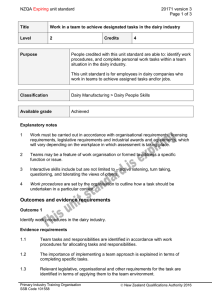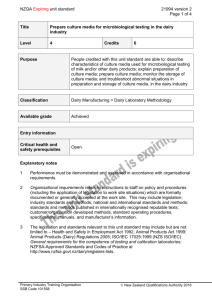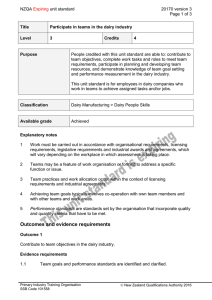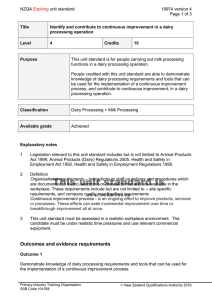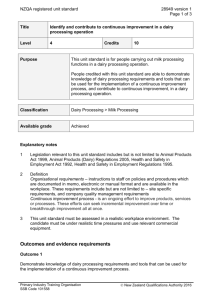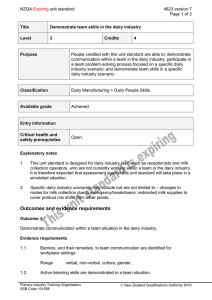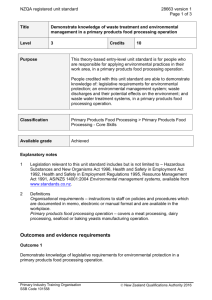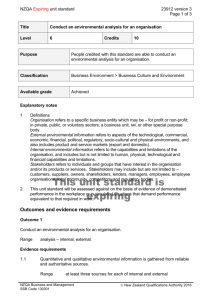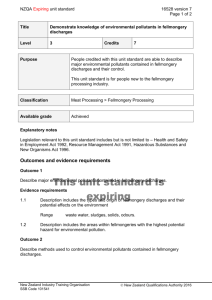NZQA Expiring unit standard 21998 version 2 Page 1 of 4 Title
advertisement
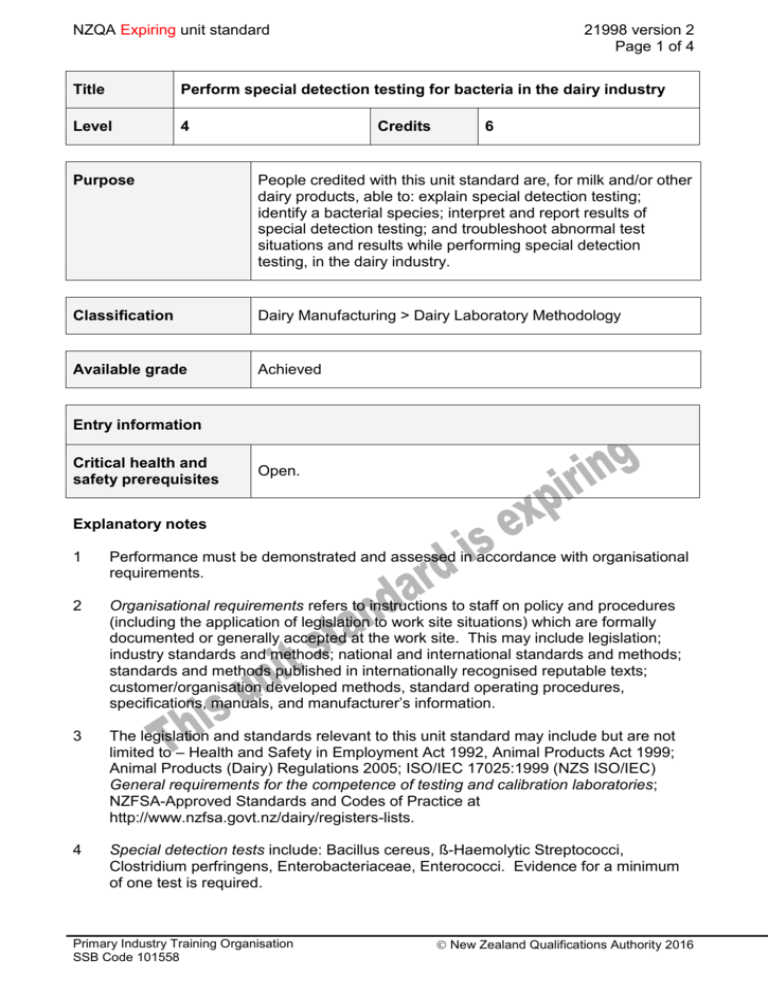
NZQA Expiring unit standard 21998 version 2 Page 1 of 4 Title Perform special detection testing for bacteria in the dairy industry Level 4 Credits 6 Purpose People credited with this unit standard are, for milk and/or other dairy products, able to: explain special detection testing; identify a bacterial species; interpret and report results of special detection testing; and troubleshoot abnormal test situations and results while performing special detection testing, in the dairy industry. Classification Dairy Manufacturing > Dairy Laboratory Methodology Available grade Achieved Entry information Critical health and safety prerequisites Open. Explanatory notes 1 Performance must be demonstrated and assessed in accordance with organisational requirements. 2 Organisational requirements refers to instructions to staff on policy and procedures (including the application of legislation to work site situations) which are formally documented or generally accepted at the work site. This may include legislation; industry standards and methods; national and international standards and methods; standards and methods published in internationally recognised reputable texts; customer/organisation developed methods, standard operating procedures, specifications, manuals, and manufacturer’s information. 3 The legislation and standards relevant to this unit standard may include but are not limited to – Health and Safety in Employment Act 1992, Animal Products Act 1999; Animal Products (Dairy) Regulations 2005; ISO/IEC 17025:1999 (NZS ISO/IEC) General requirements for the competence of testing and calibration laboratories; NZFSA-Approved Standards and Codes of Practice at http://www.nzfsa.govt.nz/dairy/registers-lists. 4 Special detection tests include: Bacillus cereus, ß-Haemolytic Streptococci, Clostridium perfringens, Enterobacteriaceae, Enterococci. Evidence for a minimum of one test is required. Primary Industry Training Organisation SSB Code 101558 New Zealand Qualifications Authority 2016 NZQA Expiring unit standard 21998 version 2 Page 2 of 4 Outcomes and evidence requirements Outcome 1 Explain special detection testing performed on milk and/or other dairy products. Evidence requirements 1.1 The principle of the test is explained in terms of technology, reactions and processes involved. 1.2 Critical stages of the test are explained. Range 1.3 Variables of the test are explained and the process of eliminating variables is described. Range 1.4 may include but is not limited to – media preparation, sample preparation, test preparation, testing, sub-culturing, reading and data input, confirmation. may include but is not limited to – equipment, apparatus, reagents, sample, technique, contamination, environment. Quality assurance of the test is explained. Range may include but is not limited to – controls, blanks. Outcome 2 Identify a bacterial species in milk and/or other dairy products. Evidence requirements 2.1 Samples and equipment are prepared. 2.2 Test is conducted according to process and procedures identified in Element 1. 2.3 Species of bacteria are identified. 2.4 Identification of organisms is confirmed using tests appropriate to prediction. 2.5 Testing is performed in a safe and aseptic manner. 2.6 Test equipment is cleaned and stored, and samples and waste are disposed of. Outcome 3 Interpret and report results of special detection testing performed on milk and/or other dairy products. Primary Industry Training Organisation SSB Code 101558 New Zealand Qualifications Authority 2016 NZQA Expiring unit standard 21998 version 2 Page 3 of 4 Evidence requirements 3.1 Results are interpreted and reported accurately. 3.2 Any non-conformance is identified and corrective action taken. Outcome 4 Troubleshoot abnormal test situations and results. Evidence requirements 4.1 Troubleshooting abnormal test situations identifies the nature of the problem, uses effective problem solving techniques and reaches a valid solution. 4.2 Troubleshooting abnormal test results identifies the nature of the problem, uses effective problem solving techniques and reaches a valid solution. Replacement information This unit standard and unit standards 21991, 21993, have been replaced by unit standard 28673 This unit standard is expiring. Assessment against the standard must take place by the last date for assessment set out below. Status information and last date for assessment for superseded versions Process Version Date Last Date for Assessment Registration 1 16 December 2005 31 December 2018 Review 2 17 September 2015 31 December 2018 Consent and Moderation Requirements (CMR) reference 0022 This CMR can be accessed at http://www.nzqa.govt.nz/framework/search/index.do. Please note Providers must be granted consent to assess against standards (accredited) by NZQA, before they can report credits from assessment against unit standards or deliver courses of study leading to that assessment. Industry Training Organisations must be granted consent to assess against standards by NZQA before they can register credits from assessment against unit standards. Providers and Industry Training Organisations, which have been granted consent and which are assessing against unit standards must engage with the moderation system that applies to those standards. Requirements for consent to assess and an outline of the moderation system that applies to this standard are outlined in the Consent and Moderation Requirements (CMR). The Primary Industry Training Organisation SSB Code 101558 New Zealand Qualifications Authority 2016 NZQA Expiring unit standard 21998 version 2 Page 4 of 4 CMR also includes useful information about special requirements for organisations wishing to develop education and training programmes, such as minimum qualifications for tutors and assessors, and special resource requirements. Primary Industry Training Organisation SSB Code 101558 New Zealand Qualifications Authority 2016
